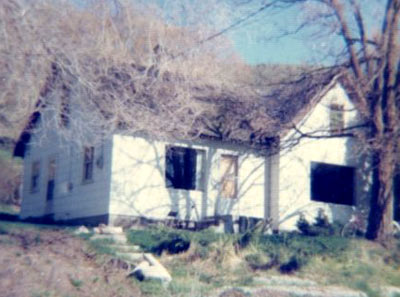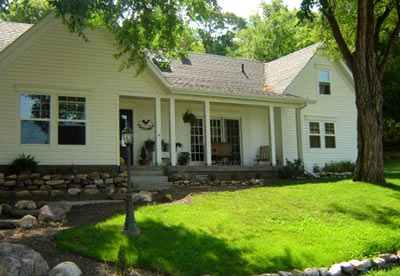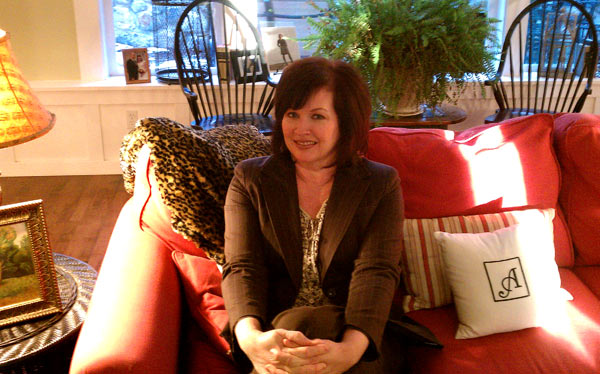For American Studies instructor, house and home is her family story
March 29th, 2011 Posted in Arts and LifeStory & Photos by Heidi Hansen
COVE—House and home. These words inspire strong feelings for most, but a quick browse on Dictionary.com shows that they have many meanings.
Susan Andersen, a lecturer in American Studies, is guiding students in English 2630, a breadth humanities course, on a journey to discover what “house and home” mean to American society and to them personally.
 “We take homes for granted,” said Andersen, who is also the associate director of the USU Writing Center. “But we’re in them every day—they contribute to who we are … and to our story.”
“We take homes for granted,” said Andersen, who is also the associate director of the USU Writing Center. “But we’re in them every day—they contribute to who we are … and to our story.”
Grant Genther, a junior psychology major in Andersen’s class, says homes tell a story of social change. “Our culture does show through our architecture and what we choose to live in,” Genther said. “Homes also show how we’ve changed … like from farming to close-knit communities.”
Ashley Whitlock, 19, is an undeclared freshman who enjoys the American Studies course and Andersen’s easy-going personality. She characterizes Andersen as thoughtful, fun and a little spacy, saying her professor can veer off-subject easily. But as Andersen frequently says in class, “everything goes in American Studies.”
Whitlock said the class is making her think about the subject in a new way. For example, she says she’d never learned the distinction between house and home. “A house is a building,” she said, “but a home is something you can feel.”
Though this is Andersen’s first semester teaching the Survey of American Culture class, her passion for the study of house and home developed over 10 years ago when she and her husband moved into his family’s 100-year-old homestead in Cove, a rural community of fewer than 500 people, north of Smithfield.
“We began tearing down walls and opening things up,” Andersen said, “and I wanted to know more about it.” Though it seems a cliché, she said she often thought, “If these walls could talk…” as she and her husband undertook the task of restoring and renovating their turn-of-the-century farmhouse.
“Susan’s interest in homes and houses is particularly appropriate,” said Paul Crumbley, director of American Studies, “because it combines the concept of home with the material reality of houses and how they are designed and constructed. The question of home has broad philosophical implications for American identity.”
Sitting in a cozy campus office with a color-coded book shelf, artwork and family photos, Andersen opened  up to discuss the story of her home and some of the answers she’s found to those broad philosophical questions related to American identity.
up to discuss the story of her home and some of the answers she’s found to those broad philosophical questions related to American identity.
Andersen, who has a gallon can of paint in her car destined for her mudroom, said she gave a lot of attention to the theme of gender roles in America as she worked with her husband to remodel their home.
“I found myself slipping into defined gender roles,” Andersen said, “despite considering myself a feminist.”
“It was always my job to clean up and sweep,” she said. “Rarely did I use a nail gun or do a lot of demo  work.”
work.”
She said the house also seems to hold a history of gender roles in America. On a wall in the basement hung a canning history, listing how much of what food was canned every year by previous occupants.
“There is a dailyness to women’s work in the home, it always needs replenishing,” Andersen said. “But a man’s work—installing cupboards in the kitchen—that lasts a long time.”
Personal family stories also became important to Andersen as she researched her house, because they can add another layer of what home means.
She said she worked hard to uncover hardwood floors that had been hidden under carpet and linoleum throughout the house. She knew the floors had been installed by her husband’s family during the Depression; the wood came from the old Cove School, which was condemned after an earthquake.
Floyd Andersen, an uncle who grew up in the house, went into the school and carefully pried up the floor boards one by one, and brought them home in good enough condition to use in their own house, she said.
“As we were uncovering the floor, we were uncovering a story,” Andersen said. “That made it hard to make changes to the house.
“It’s meaningful, it tells a story,” she said. “But times change and you have to update things.”
Andersen discovered other elements of her family story as well, such as the signature of Fred Andersen, her grandfather-in-law, on the outer wall of the kitchen.
The Andersen family bought the home in 1936, but she was also interested in learning the other stories that the house could tell about its former owners and spent time looking at property and ownership records.
“There’s something about knowing other people have been there that I find compelling,” she said.
Back in 2001, Andersen said two women showed up at her door one day, explaining that their grandfather had been born in her house. They were celebrating his 100th birthday. They pointed to a window and said he was born in that room.
“The house is part of their family heritage,” Andersen said. “For 100 years, this place had significance to them, too.”
Andersen, 49, completed her master’s degree at USU in 2004 with a thesis titled, “Becoming Indigenous: A Mosaic of House and Home.” In it, she combines creative writing about personal experiences with scholarly writing on the role of house and home in American culture.
Since then, Andersen’s three children have all attended USU and she has taught classes including English orientation and English 2010, and team-taught a tutoring practicum for the USU Writing Center with Star Coulbrooke. She also received an Innovation Grant with John Engler in 2008 for “Voices: On Stage and In Print,” a writing contest for all English 2010 students.
USU’s American Studies major, which usually enrolls about 30 to 40 students, is “an interdisciplinary approach to American culture with a strong emphasis on American literature,” Crumbley said.
He added that American Studies students are usually independent and “want to have a personal say over their course of study.” Students meet with a mentor to choose an emphasis and arrange courses accordingly, usually drawing on various disciplines, such as philosophy, art history and political science, he said.
 “The study of houses—where else would that fall?” Andersen said. “I’m not just interested in the literature or art or architecture. I want to study it all in conjunction.”
“The study of houses—where else would that fall?” Andersen said. “I’m not just interested in the literature or art or architecture. I want to study it all in conjunction.”
Andersen said that the major is usually seen as a “jumping off point for graduate school,” but added that many students go on to work at museums or attend law school. One graduate worked in Washington, D.C., for the late Massachusetts Sen. Ted Kennedy.
“In American Studies we look at text in different ways,” Andersen said. “It’s not just a book; it could be a house, a barn, a memorial, graffiti, a Hawaiian t-shirt.”
Andersen also added that American Studies is a great major for students who get bored easily. That may be why no two assignments in Andersen’s class are the same.
Throughout the semester, students participate in creative writing, film analysis and primary research projects. Class discussion topics include Walt Disney’s Main Street USA, HGTV, the White House, Indian boarding schools and historic Cache Valley homes.
“Andersen is enthusiastic about what she’s teaching,” Genther said. “She’s really studied the topic, and it shows.”
For Andersen—and her students—that enthusiasm is important.
“There are so many things we can do that are equally as important as building a bridge,” Andersen said, offering advice to students searching for a major. “Study what you really love in college.”
“I just love the idea of home, how we create a home out of a house,” Andersen said. “How lucky am I to be able to study what I love and teach it?”
TP
Tags: American Studies, Cove, family homestead, Susan Andersen

Sorry, comments for this entry are closed at this time.